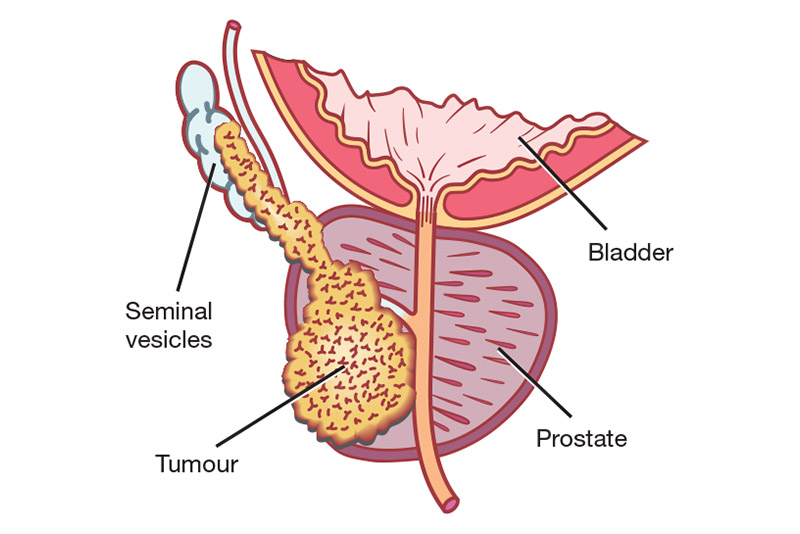
Here we overview the prostate’s anatomy and the different types, causes, risk factors, symptoms, and treatment of prostate cancer.
Prostate cancer develops when abnormal cells in the prostate gland start to mutate and grow uncontrollably and more rapidly than normal cells. These abnormal cells can sometimes grow outside the prostate and into different parts of the body.
There are slow-growing prostate cancers that will not shorten life. However, there are also more aggressive ones that can shorten lifespan. The key to prostate cancer detection is screening with your GP, who should arrange for a PSA blood test and prostate exam. If the levels are elevated, or the prostate exam is abnormal, your GP should refer you for further evaluation.
What Is The Prostate?
The prostate gland is a part of the male reproductive system. Its main role is to produce semen, the fluid that carries and protects sperm. It is about the size of a walnut and sits just below the bladder in men.
The prostate is surrounded by the upper part of the urethra, the thin tube that carries urine from the bladder to the penis. It also carries semen from the prostate and sperm from the testicles to the penis during ejaculation.
The prostate’s growth depends on the male sex hormone testosterone, which is produced by the testicles. As men get older, the prostate can enlarge, restricting the flow of urine to the urethra. This will lead to poor flow or the inability to void the bladder of urine completely.
Types of Prostate Cancer
If the cancer cells have grown but remain within the prostate, this is known as localised prostate cancer. This can be treated with success rates.
If cancer has grown and spread outside the prostate into the neighbouring organs such as the seminal vesicle or bladder, this is known as locally advanced prostate cancer. If the cancer cells have spread to the bones, lymph nodes, or lungs, this is known as metastatic prostate cancer. These are much harder to treat.
Causes and Risk Factors of Prostate Cancer
• Prostate cancer typically occurs in older men (over 50) and is mainly diagnosed in men between 60 and 80.
• If you have a family history of prostate cancer, breast cancer or ovarian cancer, you are more likely to develop it.
• A diet high in red meat and low in fruit and vegetables also contributes to the likeliness of developing prostate cancer, as does a lack of exercise.
• There is an association between prostate cancer and high testosterone levels.

Symptoms of Prostate Cancer
Early-stage prostate cancer often presents no symptoms. Even advanced prostate cancer can be symptomless. However, possible symptoms include:
• Frequent or sudden urges to urinate
• Pain or discomfort during urination
• Difficulty urinating
• Blood in the urine or semen
• Pain in the lower back, upper thighs or hips, or sciatica
When symptoms do occur, they are often linked to non-cancerous conditions such as benign prostate hyperplasia. That being said, it’s a good idea to see your doctor or urologist if any of these symptoms present themselves. Awareness and fast action are crucial when it comes to cancer.
Diagnosis and Treatment of Prostate Cancer
Diagnosis of prostate cancer may include:
Digital rectal exam: Your doctor inspects the prostate via the anus with a gloved finger to check for any abnormalities.
PSA blood test: A blood test to check PSA levels, which are proteins made by both normal and cancerous prostate cells.
Biopsy: If these tests reveal you may be at risk of prostate cancer, your urologist will take a tissue sample from different parts of the prostate for further examination by a pathologist. The prostate is accessed via the perineum – the area between the anus and scrotum. This is the only way diagnosis can be made with certainty as there is a tissue sample confirming the presence of cancer and its grade or level of aggressiveness.
Transperineal biopsy: This is the standard of care as opposed to the older technique where needles were passed through the rectal wall into the prostate – this does not allow adequate sampling of the whole prostate and exposes the patient to a high risk of infection.
Treatment of prostate cancer is complex, with disease factors and patient factors being considered. Broadly speaking, patients need to pick between robotic surgery, radiotherapy and radioactive seeds (seed brachytherapy). Other more experimental treatments exist but are best avoided at this stage.
Historically, total prostate removal was done with open surgery and led to a lot of blood loss and urinary incontinence. The current standard of care is a robotic-assisted radical prostatectomy.
Robotic-assisted radical prostatectomy: Using the da Vinci robot, small incisions are made, and robotic arms are inserted into the abdomen. The surgeon controls these at a console to complete the surgery. It allows for excellent vision and exact movements. There is much less bleeding and a quicker return to work. Patients often recover urinary control very quickly. The key to robotic surgery is an experienced surgeon.
Treating Prostate Cancer with Urology Specialist
Dr Arianayagam is an expert in robotic surgery, having personally performed well over 300 cases. He is also a proctor and expert teacher who has trained many surgeons over the years as well.
If you have any further questions about prostate cancer and would like to book an appointment, please feel free to call. Please ensure our receptionist knows that you have a high PSA or a diagnosis of prostate cancer so that we can expedite your appointment.
Want to learn more about what Urology Specialist can help with? Check out these posts below:
Smoking and its Urological Impacts

